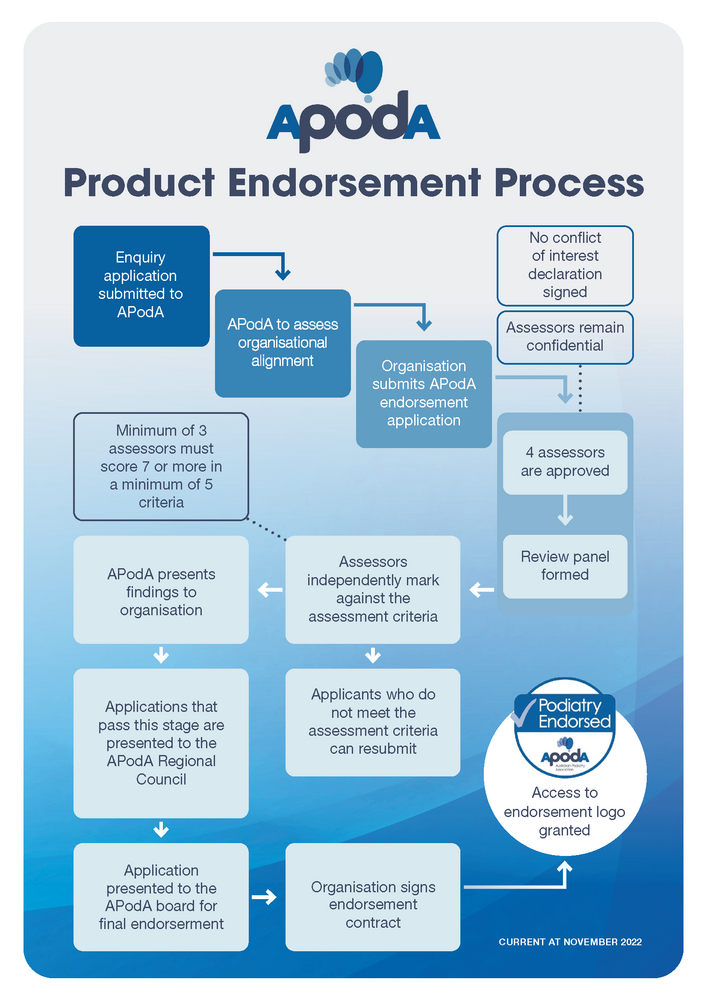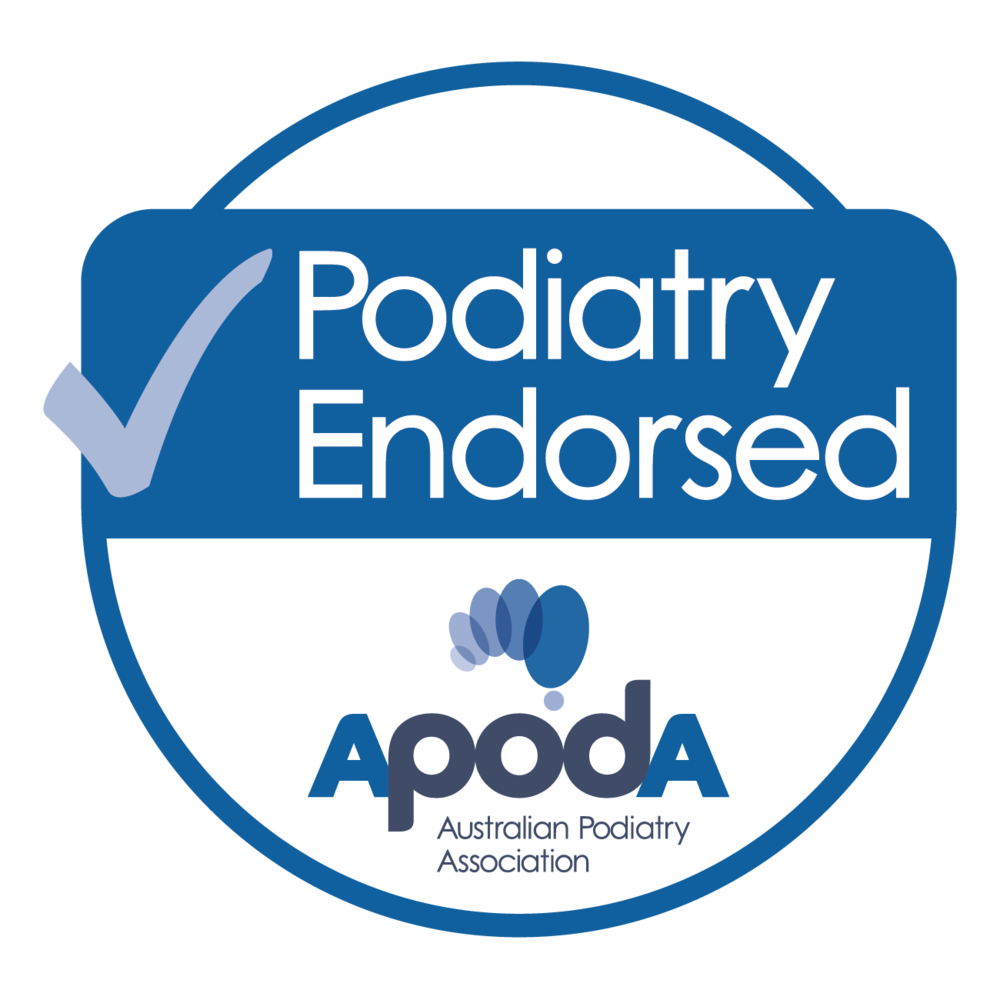Product Endorsement Program
The mutual benefit of best-practice podiatry
There is a broad and collective community benefit of applying best-practice podiatry standards to constantly improve footwear. APodA is leading this initiative to support its commitment to improve foot health. The APodA Product Endorsement Program is designed to deliver tangible benefits to all stakeholders.
Spearheading this initiative is a visible recognition of quality through the Podiatry Endorsed logo. Use of this prestigious endorsement is only earned after passing a rigorous podiatry test.
This standard serves to benefit all Australians purchasing footwear, but also includes the company representing the product, podiatrists and foot health practitioners. Already, ApodA has worked with numerous footwear manufacturer and retailer partners, to secure this gold standard in footware quality.
The APodA Podiatry Endorsed logo, provides a defining point of difference for its marketing. Specifically, the APodA endorsement differentiates products and brands, allowing them to stand out from competitors at the point of sale.
The APodA product endorsement program creates significant mutual benefit by combining several stakeholders under a common goal. It generates funds for APodA to support further podiatry research, allows brands to differentiate with an elevated quality status, whilst supporting the APodA mission to continuously improve foot health for the Australian people.
Achieving APodA Product Endorsement
Companies who have successfully passed the rigorous testing process of the APodA Product Endorsement Program, can visibly display the Podiatry Endorsed logo (under agreed terms) in all marketing communications.
The APodA Product Endorsement Program creates a partnership with organisations, entering a strategic relationship for the primary purpose of delivering improved foot-related products to market.
APodA Product Endorsement is non-exclusive and time-bound and is strictly limited to:
- the product/s put before the APodA Endorsement Review Panel (see below for information about the Panel)
- the marketing/sales messages and branding that accompany the product/s and not the company that owns the product
- the duration of endorsement as specified in the final agreed contract
The product must demonstrate a consistently high standard and quality that is recognised by the APodA Endorsement Review Panel and deemed appropriate and effective in its stated purpose.
The APodA Endorsement Review Panel
Products submitted to the APodA Product Endorsement Program, are presented to a panel of four (4) experienced, independently practising AHPRA registered podiatrists. Each podiatrist has completed at least four years of training and is required to have a minimum of 5 years industry experience, in clinical practice and is actively working in clinical practice.
If there is any actual, perceived, or potential future conflict of interest between any member of the APodA Endorsement Review Panel and the company representing the product and/or the product submitted for review, that panel member will be excused from the review process and be replaced with another reviewer podiatrist.
When reviewing the submission, any associated research and technical material is also assessed by the panel following which, any claims, sales messages and marketing statements made about the product/s are also assessed i.e., this could include point of sale materials, social media, website, direct marketing etc.
Once the APodA Endorsement Review Panel has assessed the product/s, the assessment is passed onto the APodA Regional Council and ultimately, the APodA Board for final approval.
APodA maintains a register of products/brands that have been endorsed on its website which is actively promoted to APodA members and the public.
Charter of Endorsement
The APodA Product Endorsement Program follows a rigorous assessment process.
To gain APodA endorsement, the product/s must pass the APodA Product Endorsement Program and fulfil all the following criteria:
- Related to the profession of podiatry and/or general foot health
- Of a consistently high standard
- Of merchantable quality
- Consistent with the qualities of the product submitted for approval by APodA
- Fit for the purpose for which designed
- Does not and will not offend the general public
- Consistent with the good name, goodwill and reputation of APodA
- Compliant with all applicable laws, codes of conduct, standards and regulations regulating manufacture, assembly, labelling, packaging, storage and sale in the place in which it is sold
- Not associated with any ethical concerns or misleading in terms of production, marketing and use
- Not from a company with whom APodA may have a conflict of interest
- Free of any record of poor performance or deleterious effects
- Supported by research and/or technical material where appropriate
NB: The criteria for assessment may be adjusted depending on the type of product such as athletic, school, fashion or other types of footwear.
The APodA Product Endorsement Program Process – in detail
The APodA Product Endorsement Program follows the following process:
- An organisation who is interested in seeking APodA endorsement for a specific product/s should contact APodA’s Business Development Manager
- APodA assesses the applicant to determine corporate history, future plans, quality assurance, product overview and any other information relevant to assessing the ‘corporate goodwill’ of the organisation and adherence to good podiatry practice.
When it is evident APodA and the organisation have shared goals and are aligned, the applying organisation is informed of the APodA Product Endorsement Program process. - The applying organisation submits an APodA Endorsement Application. This involves:
- The supply of 4 samples of the product for assessment
- The supply of supporting material, marketing brochures and affiliated information that will be used to promote the product
- Payment of a non-refundable Assessment fee
- Four (4) assessors are selected to form the APodA Endorsement Review Panel and assess the product and support material. Assessors are chosen on their experience/expertise in the product category being assessed.
- The identity of all APodA Endorsement Review Panel assessors is confidential and protected from outside influence. APodA maintains complete and detailed records of all reviews and products for any future reference.
- Assessors sign a ‘No Conflict of Interest (real or perceived)’ disclosure agreement with respect to the product and applicant.
- The criteria for assessment are agreed to depending on product type (e.g., athletic, school, workwear, fashion, etc.)
- Each Assessor independently completes the Product Assessment Checklist with detailed comments pertaining to the product against any claims made in the supporting material.
- At least 3 of the 4 assessors must score the product equal to, or greater than 7/10 in at least five of the eight categories of assessment in for the product to qualify for endorsement.
- Similarly, the average score across the category from all four assessors must be 7/10 or greater to qualify for endorsement
- APodA collates information from assessors and presents feedback to the applicant.
- Where there are any deficiencies, the applicant is given the option to amend the product and/or supporting material and resubmit, whereupon a full re-assessment by 4 reviewers is submitted.
- The APodA Endorsement Review Panel either confirms its support for endorsement or rejects the application.
- If supported by the APodA Endorsement Review Panel, APodA then consults with the APodA Regional Council and presents details of assessment for endorsement. The Regional Council reviews the assessment and provides further insight into the company/organisation/product/brand and can highlight any significant concerns in the process or the brand alignment.
- Where there is support from the Regional Council, the APodA Board is presented with full assessment information including feedback from the Council and full product information.
- Upon approval from the Board the applying organisation is informed and provided with a schedule of requirements and Terms of Use.
- The APodA Marketing & Communications Team ensures the APodA Product Endorsement logo is correctly used and vice versa.
Review
After a product has successfully achieved APodA endorsement, products are reviewed regularly during the life of the contract by the APodA Endorsement Review Panel. This ensures that the product continues to meet the high standards on which the original endorsement was granted.
Any intended change, deviation or alteration of the product and/or associated sales/marketing claims, statements and messages must be brought to the attention of APodA in a timely fashion so that ongoing approval and endorsement is facilitated.
Any changes to the product and associated marketing materials that occur during the endorsement period, that have not been approved by APodA, will result in voiding of the endorsement.
The APodA Product Endorsement Program Process

Product Assessment Criteria
Key Assessment Criteria
| Assessment Criteria | Overview | Rating/10 |
|---|---|---|
| Heel Support | Describes the presence and suitability of the heel counter. Usually refers solely to rigidity but may also refer to dimensions or position. | |
| Forefoot Flexion | Describes position and amount that the shoe flexes. Correct flexion should occur at the forefoot (at the Metatarsal-Phalangeal joints) and be sufficient for the joints to be able to extend through ROM. Position and depth of cuts to outsole may be considered. | |
| Torsional Stability | Refers to the amount of "twist" of a shoe. Some slight flexion is desirable but excessive amounts are not. Type of materials and density may be a factor. | |
| Contoured Arch | A contoured arch support may be present from either the insole, the upper or both. Positioning, amount of support and general comfort are primary considerations. | |
| Fastening Device/s | Laces are best, but often Velcro can give sufficient fastening. Positioning of both laces and Velcro’s must also be addressed. Sometimes poor positioning can lead to diminished results or potential areas of irritation. | |
| Toe Box | Good shape that replicates foot morphology in width and depth. High marks may be awarded for extra widths. | |
| Cushioning | This may refer to insole or combination of insole and shoe construction. Factors such as construction material and durometer may be referred to. | |
| Removable insole | Removable insoles may aid in potential use of orthoses or double layers of insoles may aid in footwear fitting. | |
| Rating | /80 |
Additional Criteria
This may vary from product to product and might encompass features beyond the Key Assessment Criteria or alternatively areas where improvements may be made.
| Assessment Criteria | Overview | Rating/10 |
|---|---|---|
| Breathability | General assessment | |
| Shoe Materials | General description of materials used in outsole and upper. May include factors such as stitching placement as well as a general comment on materials used. | |
| Slip Resistance | Assess any supporting data. A cursory test may be performed | |
| Durability of Outsole | Assess any supporting data. |
Endorsed by APodA logo

